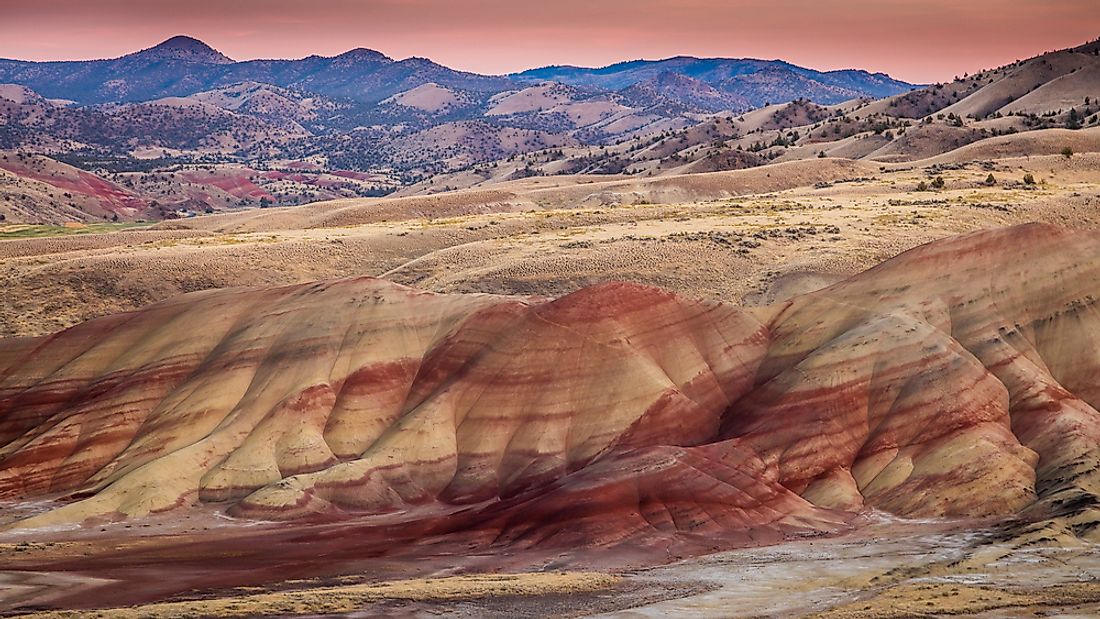John Day Fossil Beds - Unique Places in North America

The John Day Fossil Beds National Monument is one of America’s tourism jewels. The breathtaking expanse is subdivided into three parts: The Sheep Rock, The Painted Hills, and The Clarno, each with a unique pattern, dotting, and geologic structure. The fossil monument once hosted plants and animals dating 5 to 50 million years ago. These died forming the fossils we have today. Visitors from all over the world venture in recreational activities such as hiking within this 5,691 hectares stretch of natural magnificence.
Description
The John Day Fossil Beds National Monument was established on October 8, 1975, and features hills, deep valleys, eroded fossil rocks, and a river- the John Day River. These features are contained within the three sections, giving each a different and spectacular visual appeal. The Sheep Rock is the largest and is located at the John Day River at the upstream side of the Kimberly community along the Oregon Route 19. The second largest portion is the Painted Hills, covering a vast 1,267 hectares, 9 miles northwest of Mitchell. The Clarno unit is the least, covering 797 hectares and is located 18 miles west of Fossil. A unique facility within the monument is the John Day Fossil Beds is the Thomas Condon paleontology site which is primarily a questions and answers platform for the visitors.
Habitat
Mammals that once inhabited the area include browsers such as the amynodot and the brontotheres, predators like the patriofelis, and the hyaenodont. These existed roughly 30-45 million years ago. In the past 7-20 million years, fossil studies reveal the inhabitation of close to 100 animal and 60 plant species within the John Day region. There are about 80 types of soils identified in the region and support a wide array of plants species. The birds and animals in the region have been identified to be in the tune of more than 50 species.
Threats
According to the study by the UCBN in 2010, it paints a bleak picture of the quality and quantity of water on John Day River and Bridge Creek. The water from the two rivers is crucial in maintaining the populations of trout and salmon. The temperature of water in Bridge Creek exceeded the requisite threshold designated for trout/Salmon rearing/migration. The pH also exceeded the upper limit of 9.0 pH units. Similarly, dissolved oxygen most of the time fell below the required limits of 6.5 mg/l.
Tourism
Entrance into the exhibits and museum is free of charge. This is one of the reasons why it hosts large numbers both locally and internationally. Additionally, John Day Fossil Beds features a paleontology center known as the Thomas Condon and is open all year round, except for public holidays. The reason behind the national monument attracting a large number of visitors is the myriad of recreational activities. Visitors can take part in hiking, biking at specific trails, fishing, and rafting at the John Day River.
Uniqueness
The John Day Fossil Beds National Monument is unlike any feature you will see anywhere in North America. The Sheep Rock is colorfully adorned with red, blue, and grey rocks that outcrop at the sloping hillsides. At its northern part is the James Cant Ranch which dates back to the 20th Century by a Scottish couple. On the Eastern side is located the Thomas Paleontology Center which features a fossil museum, theater, classroom, and a bookstore. The Painted Hills features red and orange color bands whose intensity changes according to light conditions and the weather. Also featured in the Painted Hills are the Red Hill, the Painted Cove Trail, and a multi-colored mound of clay. The Clarno is the least of the three and features nature trails.











